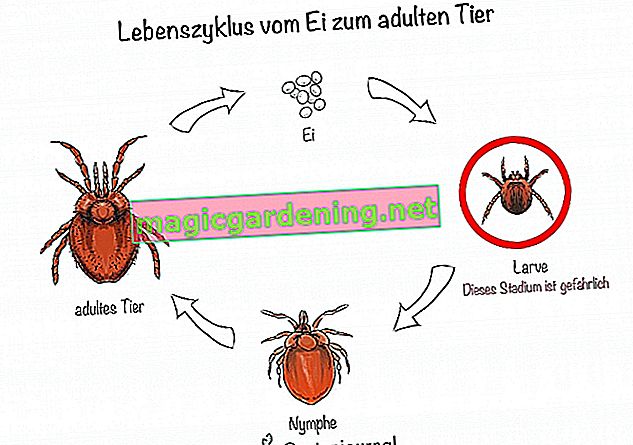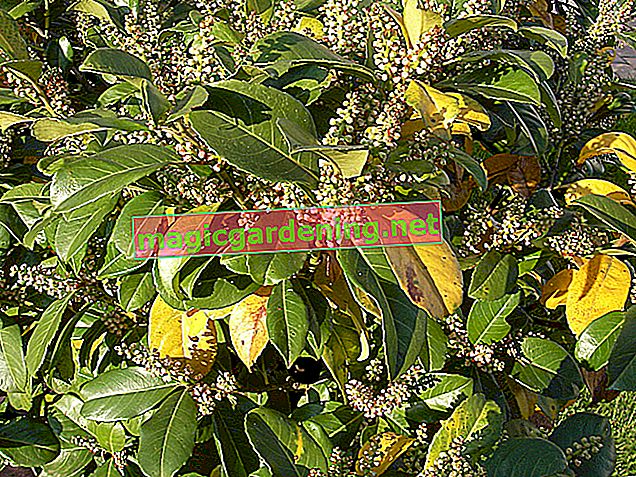
the essentials in brief
- Bites are usually only recognized when the autumn mite has fallen off; then ugly wheals develop, which can become infected by scratching
- Regular mowing and watering of the lawn keeps grass mites in check
- Neem oil or nettle stock are natural home remedies against grass mite infestation in the lawn
- The bite should be immediately disinfected with alcohol and can then be treated with antibacterial and / and anti-inflammatory agents such as essential oils
Recognize stitches
Autumn mite bites lead to so-called harvest scabies in most people, also known as gooseberry disease. A bite does not cause pain and is usually not noticed immediately. After the larva has fallen from the bite site, it can take up to 24 hours for the first symptoms to appear.
also read
- June beetle - detect, prevent and fight
- Rose petal wasp - recognize, control, prevent
- Preventing, recognizing and combating powdery mildew on boxwood
The bite creates numerous reddish dots that are reminiscent of small mosquito bites. Frequent scratching causes the bite wounds to swell into wheals. The symptoms subside after about ten to 14 days. The symptoms are similar in animals. If the pets are incessantly scratching and the dog is licking their paws, fall mite infestation may be an issue. Horses also suffer from severe itching. You scratch yourself at every opportunity, causing weeping, crusted sores, and inflammation.
From bite to wheal:
- Larva bites its skin
- Salivary secretions are injected
- Lump formation at the puncture site
- Nodules enlarge into vesicles
- Scratching open the blisters leads to the subsequent infection
Different skin reactions
Some people have an extreme rash that is reminiscent of an allergy. The wheals can appear all over the body, even if the larva has only suckled in one place. In these extreme forms, the skin becomes very itchy. Some people hardly show any symptoms. There are people who are desensitized after an initial attack. If the infestation occurs again, there are no more complaints.

Affected areas of the body
The larvae prefer moist, warm areas of the body where the skin is particularly thin. Armpits or skin folds on the abdomen or in the genital area are among the most frequently affected areas, but the legs, scalp and ears are also occasionally affected. The arachnids also feel comfortable under close-fitting clothing, so that they can also settle under the edges of socks, underwear or the waistband.
In dogs, the parasites often settle on the legs, stomach, chest, and ears. They can also affect the paws when the dogs roam through the vegetation. Cats often suffer from bites in the temples and ears. The mites also appear on the tip of the tail and remain on the animals' skin for several days.
Fight grass mites
To protect against grass mites in the garden, you should mow the lawn regularly and keep it moist. In wet conditions, the mites withdraw into the ground and no longer pose a threat to humans or animals. Remove the clippings from the area so that the arachnids are stolen from their livelihood. If you know that grass mites live on the lawn, you should burn the clippings or dispose of them in the general waste.
YoutubePyrethrum as a natural insecticide
Pyrethrins are natural substances that are contained in various plants and have an insecticidal effect. The substance acts on the nervous system. The dalmatian insect flower (Tanacetum cinerariifolium or Chrysanthemum cinerariaefolium) is not called the insect powder plant for nothing, because it develops two different pyrethrins and is used for the production of biological pesticides. The active ingredient is contained in the tick and grass mite concentrate from Neudorff and can be used on the lawn to combat grass mites.
Disadvantages of the natural insecticide:
- Ingredients also kill beneficial insects
- slightly irritating to the skin
- irritate eyes and mucous membranes
- fatal poisoning possible for humans and pets
Treat lawns with home remedies
Fertilize your lawn regularly with nettle manure or neem tea. Mix a small cup of neem oil or nettle stock with five liters of water and pour the solution onto the grass mite nests. The arachnids are usually not distributed over a large area, but rather stay in certain places with optimal conditions. Use a white cloth to locate the nests.
Tips
You can also dab the nests with 70 percent alcohol so that as many of the larvae as possible die. But be careful: this can also damage plants and beneficial organisms.
Scarifying
If your lawn is prone to the formation of moss, you should thoroughly scarify the area in the spring. This loosens the sward and turf thatch and dense moss pads, in which grass mites feel comfortable, are removed. In the well-ventilated turf there are suboptimal conditions for the arachnids to spread. Then fertilize the lawn so that the grass can prevail over the moss.
Tips
Fertilizing with lime and nitrogen is said to have helped one or the other hobby gardener in the fight against the grass mite plague. Apply the fertilizer on a dry day after mowing in early May.
Treat bites in humans and animals
In adults, only the symptoms are treated as the stitches usually go away on their own. To relieve the itching, the doctor will prescribe ointments containing cortisone or anihistamine. To reduce the swelling, you can put cooling compresses on the affected areas. Warmth in bed should be avoided in the first few hours after the symptoms appear, as it makes the itching even worse. If the stab wound becomes infected or bacteria appear, the doctor may use an antibiotic.
Medical products for pets
If the infestation has become widespread and your pet is tirelessly scratching itself, medical treatment is essential. A visit to the vet is necessary at the latest when open or weeping wounds appear on the skin. The vet prescribes various remedies that specifically help against the pests.
| shape | effect | application | |
|---|---|---|---|
| Frontline | Spray, spot-on | insecticide, acaricide | externally |
| Cetirizine | Tablets | against itching | inside |
| Sebacil | solution | insecticide, acaricide | externally: immersion bath |
Gentle shampoos for children and babies
Often the larvae bite into the scalp of babies and toddlers so that the entire head is covered with itchy redness. Gentle shampoos with willow bark extract provide a remedy for humans, dogs and cats. Willows contain salicin. This substance soothes itching and weakens inflammation. The scent of special shampoos has a deterrent effect on the arachnids. Herbal mixtures with willow bark and meadowsweet have also proven to be beneficial against grass mite bites in horses, because they promote wound healing.
Mild and natural soaps for pets
If the entire body of the dog or cat is infected by grass mite larvae, an extensive bath with special soap can help. The soaps should be free from synthetic additives and intense odorous substances. Rose, sandalwood or sage care for the skin. Nettle or marigold extract cleanses the fur and protects the skin and nose. Lather the soap with your hands and distribute the lather thoroughly in the fur and on the paws. Let the soap work briefly so that the larvae are scared off.
Tips
Put a bowl of water and soap solution near the front door. So you can clean the dog's fur with a cloth after every walk.
Treat grass mite bites with home remedies
If you or your child have been attacked by grass mites, you should immediately rub the reddened bite areas with 70 percent alcohol. This disinfects the area and ensures that there are no subsequent bacterial infections. Skin-friendly products from the kitchen, which can usually also be used on pets, are suitable for treating the bites.
If the itching becomes unbearable, you can spread quark on the affected areas. The dairy product has a cooling effect that can relieve itching. It also promotes wound healing. You should avoid acidic products such as apple cider vinegar or lemon juice, as these irritate the skin additionally. In addition, their usefulness has not been confirmed.
| ingredients | effect | for pets | for children | application | |
|---|---|---|---|---|---|
| Coconut oil | Lauric acid | caring, antimicrobial and caring | suitable | suitable | internally, externally |
| Neem oil | Azadirachtin, essential oils | repulsive, calming, anti-inflammatory | Conditionally suitable: should not get into the mouth or nose | suitable from 4 years | externally |
| Black seed oil | unsaturated fatty acids, linoleic acids, essential oils | pain reliever, anti-inflammatory | suitable | suitable | internally, externally |
| Tea tree oil | essential oils | disgraceful, fungicidal, antibacterial, antimicrobial | not suitable | suitable from 3 years | externally |
Homeopathic and alternative treatment
Anyone who trusts in homeopathic remedies to help with grass mites can use special globules. These are an over-the-counter alternative to chemical drugs that can treat symptoms naturally. The recommended dose is five globules taken three to eight times a day. Regular use is intended to relieve itching and soothe severely inflamed skin.
These globules are used against itching:
- Cardiospermum : balloon plant - D12 globules
- Apis mellifica : honey bee - D6 globules
Amber
The fossil resin is considered to be an effective weapon in deterring grass mites. There are collars for dogs that are supposed to release essential fragrances when rubbed, thereby scaring off the annoying arachnids. Other theories state that the animal's fur is electrically charged by the friction and thus drives away the mites. Many dog owners swear by the effects, although it's not confirmed.
Prevent infestation
Postpone walks with the dog to the early hours of the morning, because then the larvae are less active. To protect yourself and your children, long clothes and shoes with a high shaft should be worn. As a result, the larvae hardly have any opportunity to crawl onto the skin. Since long trousers and sweaters are usually uncomfortable on hot summer days, you should take further preventive measures.
Children: sprays or creams
A good measure for prevention are gentle agents on a natural basis that work against annoying insects. Rub your child's legs and arms with a skin-friendly anti-mosquito cream. Children are often sensitive to essential oils, which is why the products should not smell too intense. It should also help to wipe the skin with the palm of your hand every half hour. Since the larvae do not bite firmly when they land on the skin, they can be removed by rubbing them off.
Digression
Citronella and eucalyptus oils
Both oils contain essential fragrances that act as deterrents to grass mites. Applying it to the skin ensures preventive protection that can last up to five hours. However, the oils should not be used in children. Breathing problems and skin irritation can occur.Double-sided tape
A reliable crawl protection against grass mites is white adhesive tape, which has adhesive surfaces on both sides. Glue a strip over the upper part of the shoe so that it is completely encircled. When the animals get on the shoe and crawl up, they stick to the tape and perish. To be on the safe side, you can also wrap your wrist with tape. However, when the children are rolling in the grass, this preventive measure reaches its limits.
Pets: feed brewer's yeast
Numerous pet owners swear by brewer's yeast as a natural means of preventing grass mite infestation, although its effectiveness has not been scientifically proven. The B vitamins contained, which accumulate in the subcutaneous tissue and change the smell of the skin, should be responsible for the positive effect. This change in smell is not perceived by humans, which probably led to doubts about the effect. Grass mites are supposed to perceive the smell, making the host unattractive.
Good to know:
- should be fed daily
- suitable for dogs, cats and horses
- The taste is reminiscent of cheese
- Dogs and cats are fed one gram per ten kilograms of body weight every day
About the animal
Behind the pest known as grass mite hides a type of running mite that bears the scientific name Neotrombicula autumnalis. It has nothing to do with the actual grass mite (Bryobia graminum), which mainly feeds on plant sap. The dreaded grass mite is one of the parasitic mites that target animal and human hosts. Their bites can cause severe itching, combined with reddening of the skin.
Other names for grass mites and their meaning:
- Autumn mite : indication of the season in which it becomes a nuisance
- Harvest mite : occurs mainly during harvest
- Hay mite : in the past, farmers were often bitten while making hay
Way of life
Adult animals become active in April when the weather is good. They colonize the stem base of grasses and mosses in order to suck the sap out of the ducts. When heavy rains occur, the mites retreat up to half a meter into the ground. They prefer dry weather, but can hardly survive in low humidity.
The larva lives on the tips of moss pads and blades of grass. It can climb a height of between five and 20 centimeters to wait for a suitable host. Grass mite larvae parasitize on living things whose body temperature is between 30 and 40 degrees Celsius. Mainly they target birds, rodents and domestic animals, which they besiege for several days. Mice in particular are attacked by the annoying pests.
Humans also fall into the prey scheme of grass mites, although they are not among the main hosts. The mite larvae only stay on humans for a few hours to suck up lymph and cell juices.
What happens with a bite:
- Mouth parts scratch skin
- Salivary secretions, which dissolve the tissue, get into the wound
- capillaries are rarely injured and blood sucked
development
Depending on the weather, the arachnids multiply in warm seasons between spring and autumn. They can occur from April to October, with their peak season in Europe being between July and October. The non-parasitic females lay their eggs on the ground, from which larvae hatch after four weeks. The development of a larva into an adult takes place in three nymph stages.
After the newly hatched larvae have suckled themselves, they let themselves fall from the host and go into a dormant state in order to subsequently moult several times. Adult mites survive the winter. They protect themselves against frost by retreating 60 to 90 centimeters into the ground. When the larvae hatch late in the year, they too can survive in the substrate.

What do grass mites look like?
The larvae are invisible to the naked eye because they grow to a maximum of 0.3 millimeters. Her body is flattened at the rear end, colored orange-red and has a broad shield on the back. This is pentagonal shaped and covered with sensory hair and feathered bristles. The six-legged larvae have long hair that they use for touching. The insects can perceive their surroundings with two double eyes. They have strong jaw claws that each end in a claw.
Adult mites reach a size of two millimeters. Her body is strongly constricted behind the shoulder and colored intensely red. The back is densely covered with bristles. Unlike the larvae, the adult mites move with eight legs. These are bristly haired and each have two claws that are used to hold on.
Where grass mites feel good
Once the arachnids have gained a foothold in one location, they are difficult to get away from. However, this only applies to natural habitats that offer the autumn mites dry and warm conditions.
Natural occurrence
The name grass mite suggests its habitat. The arachnid is common all over the world and inhabits open landscapes with low vegetation. In addition to meadows and arable land, this also includes gardens, which is why garden owners can also be bitten. Grass mites prefer regions with warm temperatures. The population density of the pests is very high in the Rhineland and in parts of Hesse and Bavaria.
garden
Grass mites can be introduced into the garden by supplying fresh topsoil. Before you order soil, you should find out about the region. Choose sources that are outside the main distribution areas. Grass mites can also get into the garden through domestic animals, wild animals or birds.
Warblers love bright and warm surfaces, which is why they like to crawl on white paper.
Apartment and house
Although the arachnids can get into the home through clothing or in the fur of pets, you don't have to worry about pests spreading around the home. If the mites drop and land on the floor after sucking, they will not find ideal living conditions. They die off after a short time.
So that grass mites do not get into the house:
- Wash worn clothing with hot water
- Vacuum floors and carpets thoroughly
- Soap body and shower off
- Clean shoes
frequently asked Questions
At what temperature do grass mites die?
Grass mites have adapted to life on the surface of the soil. They look for areas in which the small-scale climate is optimal. The larvae prefer temperatures between 16 and 25 degrees Celsius, but the arachnids slowly become active at temperatures above ten degrees. If temperatures between 35 and 40 degrees Celsius prevail over a longer period of time, the larvae try to escape. The microscopic living beings can, however, survive temperatures of up to 45 degrees if they only last for a short time.
As soon as the temperatures drop into the single-digit range, the living beings withdraw into the protective soil. Usually the substrate does not freeze completely, so that the grass mites survive the winter in a resting state.
How long do grass mites live?
There is no clear information about the exact lifespan of the autumn mite. The larvae take several weeks to develop into an adult. Even if the arachnids can overwinter, it is not certain whether a female will survive several generations.
How long do grass mites survive in the apartment?
Grass mites and their larvae need a comparatively high level of humidity to survive. Between the leaves and blades of grass there is an average humidity of around 70 percent. The larvae feel particularly at home here. Nevertheless, they must be able to survive short-term fluctuations. On the host, the arachnids first have to crawl into the protected areas so that they are exposed to a lower level of humidity.
In apartments there is usually a humidity between 40 and 60 percent. Although grass mites find optimal temperatures in the house, they cannot survive for more than ten to 20 hours at a relative humidity of 50 percent.
Do grass mites survive in bed?
There is no risk of settlement in bed, as this environment does not correspond to the natural habitat. Unlike house dust mites, the larvae of the autumn mites die off after a short time and cannot develop any further. Adult grass mites do not look for hosts and normally do not come into the apartment. Should they get lost there, they won't survive long in the unnatural environment either.
Can grass mites be transmitted from animals to humans?
Grass mite infestation is usually not contagious. When the arachnids have found a suitable host, they cling to certain parts of the body. After soaking, they drop to go to sleep. This means that another host change from domestic animals to humans is impossible. An infestation by the mite larva only occurs when there is direct contact with the mite focus.








